Nestled in the heart of the Aegean Sea, Milos is a unique Greek island celebrated for its geological wonders. Formed by millennia of volcanic activity, dramatic cliffs, sculpted rocks, and therapeutic hot springs have come to define the island. Standing out from the vast Greek archipelago, come join me in exploring the volcanic landscapes and hot springs of Milos.
The Geological Marvels of Milos – Volcanic Landscapes and Hot Springs
Milos’ dramatic geological story began millions of years ago, ultimately shaping the landscape we see today. Millennia of volcanic eruptions and geological activity gave rise to the island’s distinct features. The island’s central caldera is a vast crater formed by the collapse of an ancient volcano. Lava flows, ash deposits and subterranean materials erupted from volcanic events sculpted the island’s terrain.
One of the most remarkable impacts of this volcanic era is the diverse range of rock formations scattered across Milos. These formations, varying in color and composition, paint a telling mosaic with rock types such as obsidian, pumice, and rhyolite, carrying their own geological tale.
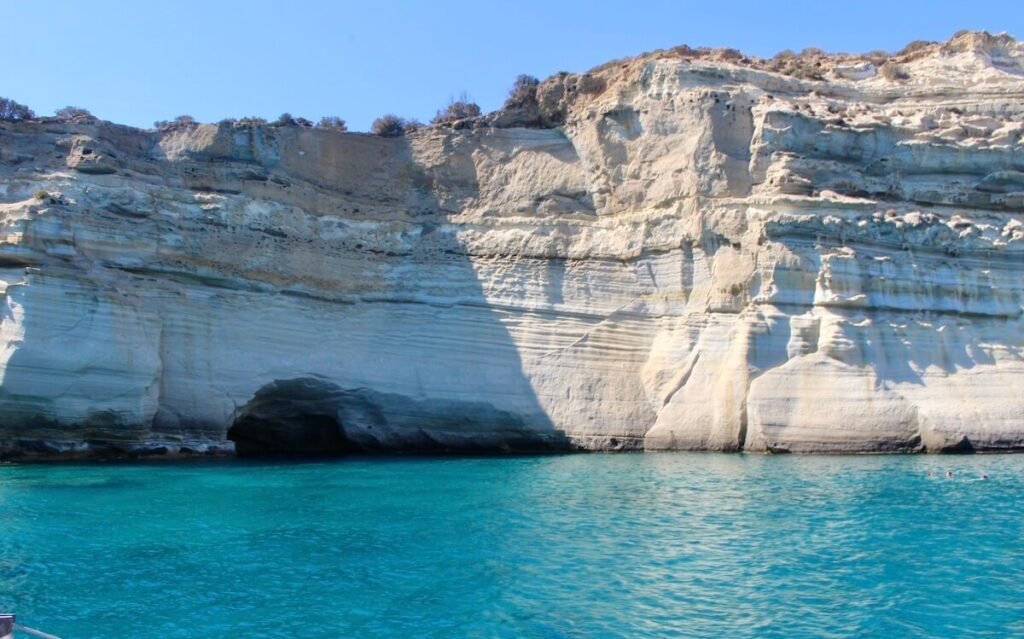
As the volcanic activity gradually waned, the forces of erosion took over, carving gorges, cliffs, and sea caves. Wind, water, and time have converged to craft sites like Sarakiniko Beach, where smooth, white volcanic rocks shaped by the sea create a moon-like landscape.
In essence, Milos’ volcanic history is a tale of fire and fury, of creation and transformation, and a reminder that nature’s forces can shape a land in ways that are remarkable.
Exploring the Iconic Volcanic Landscapes
Milos top volcanic sites and ancient geological wonders provide a unique opportunity to witness the raw power of nature. From the lunar landscapes of Sarakiniko to the hidden treasures of Kleftiko’s sea caves, Milos’ volcanic sites invite explorers to immerse themselves in a world sculpted by the Earth’s fiery history.
Here are some of the island’s most iconic volcanic sites:
Sarakiniko Beach
Sarakiniko is a surreal, white, lunar-like, volcanic rock beach that contrasts dramatically against the deep blue waters of the Aegean. Wind and waves have sculpted the smooth and curvy rocks, creating a moonscape that seems to belong to another planet. It’s a photographer’s dream and a place that invites adventurous beachgoers to walk (and jump) the sculpted cliffs and lay and swim on a beach unlike any other.
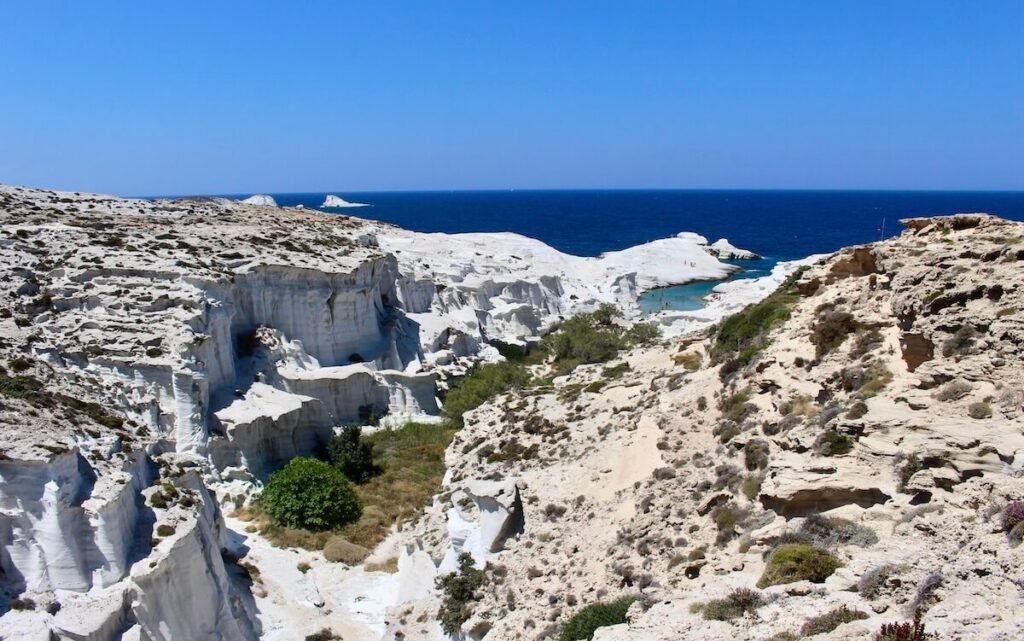
Papafragas Beach
Nestled within a volcanic canyon, Papafragas Beach is a defined by its stunning natural rock arch and crystal-clear turquoise waters. The high volcanic walls that encircle the beach add a touch of mystique, making it an ideal spot for a refreshing dip or a leisurely kayak ride through the narrow gorge.
Firiplaka Beach
This beach is a vivid showcase of Milos’ volcanic history, with its strikingly colorful cliffs and rugged shoreline. The vibrant hues, ranging from red and orange to pink and yellow, result from the presence of various mineral deposits in the volcanic rocks. It’s an excellent spot to appreciate the island’s geological diversity whilst soaking in the sun.
Sulphur Mines of Paliorema
These historic mines offer a glimpse into Milos’ past as a sulfur mining hub. The volcanic landscape is marked by abandoned structures and surreal, yellow-hued deposits, showcasing the island’s historical reliance on its geological resources.
Kleftiko
Accessible only by boat, Kleftiko is a collection of sea caves, tunnels, and towering volcanic cliffs rising from the sea. The result of volcanic activity and relentless coastal erosion, Kleftiko’s dramatic geological formations form a labyrinth landscape ripe for exploration. Snorkeling, swimming, and diving around these ancient volcanic structures reveal a mesmerizing underwater world.
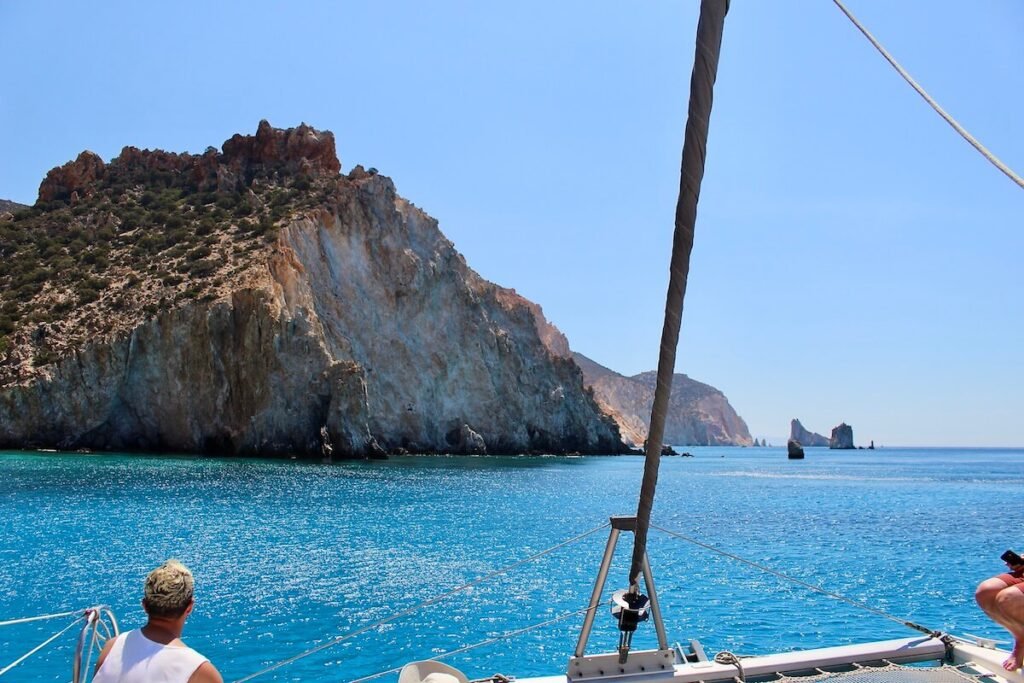
Taking a Dip in Milos Hot Springs
The hot springs of Milos owe their existence to thousands of years of volcanic activity. The heat generated by the Earth’s core warms surrounding rock formations and water, causing it to rise to the surface through fractures and vents. Underground water reservoirs are heated and eventually lead to the formation of these inviting pools. As water percolates through layers of rock, it absorbs minerals and elements, contributing to the distinct healing properties that many hot springs in Milos are renowned for.
Hot springs are often rich in minerals like sulfur, calcium, magnesium, and silica, which can have therapeutic effects on the human body. The warmth of the water promotes relaxation, while the minerals may offer benefits such as improved circulation, relief from muscle tension, and even benefits for skin health.
Milos’ hot springs offer visitors a chance to embrace the natural warmth and therapeutic waters. Here are the different hot springs found on the island:
Adamas Hot Springs
Situated near the island’s main port town of Adamas, these accessible hot springs offer a convenient relaxation option for visitors. While not as elaborate as some other hot springs on the island, they provide a soothing experience. The Adamas hot springs are an ideal choice for travelers looking to unwind after a day of exploration or before embarking on their island adventures.
Loutra Hot Springs
Loutra, located in the northwestern part of Milos, is famous for its natural thermal baths that have been cherished for their healing properties since ancient times. These hot springs are set against a backdrop of stunning coastal views, creating a serene environment for relaxation. The mineral-rich waters of Loutra are believed to have beneficial effects on skin conditions, muscle aches, and overall well-being. Loutra’s hot springs offer a truly holistic experience where the soothing waters combine with the island’s natural beauty.
Alikí Hot Springs
Found near the village of Alikí, these hot springs offer a rustic and natural experience for visitors seeking to connect with Milos’ geothermal wonders. The setting is characterized by bubbling waters that rise from the depths, creating small pools where bathers can enjoy the warmth. A visit to Alikí’s hot springs is a chance to experience the simplicity and purity of geothermal bathing in a tranquil setting.
Zefyria area
The village of Zefyria is a unique geothermal area where thermal waters have interacted with deposits of kaolin clay, giving the surroundings an otherworldly appearance. While not a traditional hot spring for bathing, the white clay mud that can be found here is used by visitors for therapeutic purposes. Applying the mineral-rich mud to the skin is believed to have cleansing and revitalizing effects.
So, whether you’re seeking relaxation, wellness, or just a great experience on a unique island, Milos’ hot springs are not to be missed.
Activities and Recommendations in Milos
Milos has plenty of outdoor activities that complement its volcanic landscapes and hot springs. From hikes and trails to scuba diving and snorkeling, there’s something for all types of explorer. These are my best suggestions:
Hiking Trails
Hike to Kleftiko, to explore the iconic sea caves and cliffs formed by volcanic activity. The trail takes you through diverse landscapes and offers great views of the coastline finishing in the awe-inspiring Kleftiko formations. A great way to explore on foot if you are fit enough.
This coastal hike from Fyriplaka to Tsigrado offers a chance to witness the colorful volcanic cliffs up close. The trail leads you through landscapes, descending on to the hidden Tsigrado Beach for a rewarding swim.
For panoramic views of the island’s volcanic terrain, hike to the summit of Profitis Ilias or the ancient ampitheatre of Milos. Both offer breathtaking vistas that stretch across the Aegean Sea and the surrounding islands.
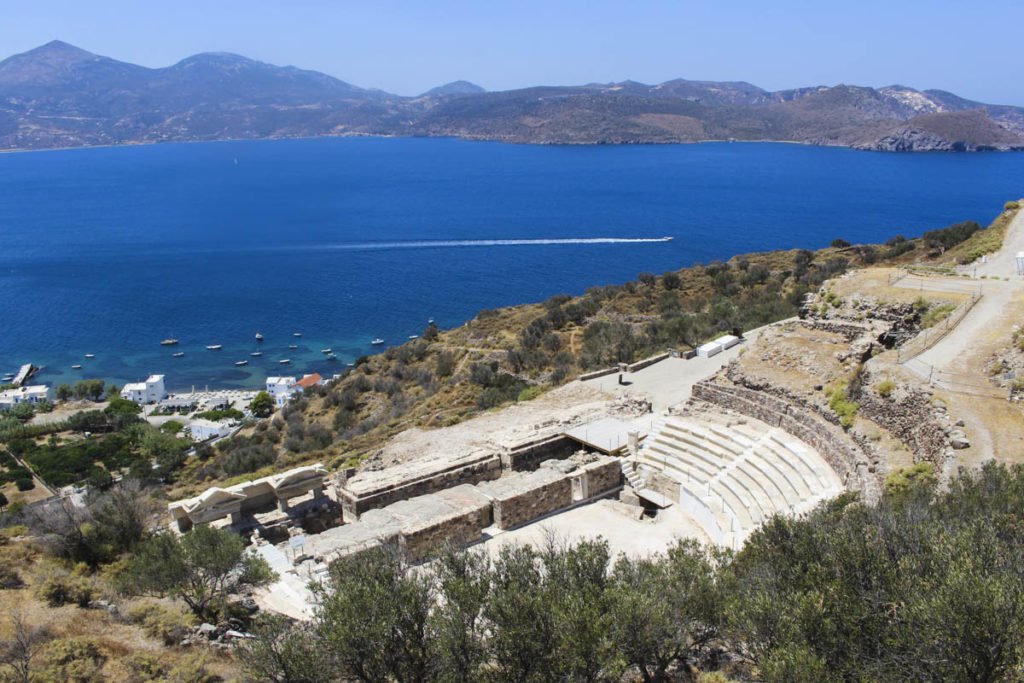
Snorkeling and Diving
Snorkel around the underwater world of Kleftiko’s sea caves and tunnels. Here, you can explore and witness the fascinating marine life and the volcanic formations beneath the water’s surface. Also, consider diving and exploring the shipwreck off the coast of Cape Vani. The wreckage is a testament to Milos’ maritime heritage and provides an intriguing underwater adventure.
Kayaking sea caves
Sea kayaking offers yet another way to experience Milos’ volcanic formations and coastal beauty. Paddle along the coastline to explore sea caves, tunnels, and hidden coves. Kayaking during golden hour allows you to witness the colors of the sky as the sun sets over Milos’ volcanic landscapes.
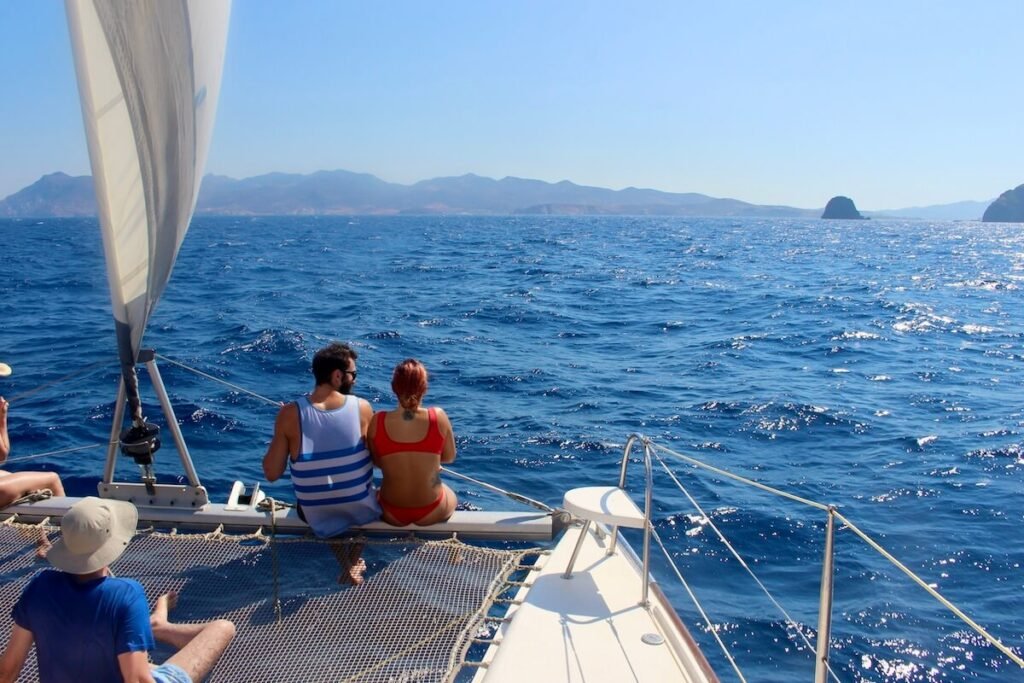
Boat Tours
Join a Milos boat cruise that takes you on a tour along Milos’ volcanic coastline, stopping at landmarks such as Sarakiniko, Papafragas, and Kleftiko. The boat’s perspective offers a unique angle to appreciate the island’s geological wonders in one day. Combine relaxation by taking a boat tour that includes stops at the island’s hot springs allowing you time to enjoy a warm soak in therapeutic waters.
Ampitheatre
The Milos Amphitheatre, also known as the Ancient Theatre of Milos, is an ancient Greek theater dating back to the Hellenistic period. It’s carved into the rocky landscape of Milos and is known for its position overlooking the sea. This well-preserved amphitheater once hosted performances and gatherings, and today, it serves as a historical and cultural attraction, offering visitors a glimpse into the island’s rich heritage and providing a picturesque backdrop for exploration.
Tips when visiting Milos for Volcanic Landscapes and Hot Springs
The best time to visit Milos is in the late spring, summer and early autumn. The shoulder seasons are balanced between warm weather, fewer crowds, and more affordable prices. Summer is perfect for beach lovers and those seeking a vibrant atmosphere.
Late Spring
May to June is an excellent time to visit Milos. The weather is warm but not to the extreme and the island is adorned with lush vegetation and colorful wildflowers. Sea temperatures are starting to rise, making it possible to enjoy swimming and water activities. Tourist crowds are relatively thin compared to the peak summer months, allowing for a more tranquil experience. Late spring is ideal for outdoor exploration, including hiking and sightseeing, as temperatures are moderate.
Summer
The months of July and August are the peak tourist season in Milos. Warm temperatures and clear skies make it ideal for beachgoers and water enthusiasts. This is the best time for swimming, snorkeling, and enjoying the island’s numerous beaches. While the island is more vibrant with festivals and events during this period, it’s also the busiest, so be prepared for larger crowds and higher accommodation prices. Advance booking for accommodations and activities is recommended during summer.
Early Autumn
September to October offers pleasant weather with warm days and cooler evenings. Sea temperatures remain inviting for swimming. Crowds begin to thin out after August and is an ideal time for exploring Milos’ natural beauty, including hiking and enjoying outdoor activities, without the intense summer heat.
Where to stay in Milos to Explore Volcanic Landscapes and Hot Springs
There are plenty of hotels and Airbnb options in Milos that are perfect for explorers and families. Though Milos is getting more popular with every passing summer, don’t expect the abundance of resorts that exist on more popular islands. Make sure you read my blog post on the best places to stay in Milos for a detailed guide. There are three main towns to stay. Adamantas is the port town and where all the ferries and sailing boats dock. Plaka is the beautiful and lively Chora (the main town), effectively the “capital of the island”. And Pollonia is a small seaside village located on the Northeastern tip of the island.
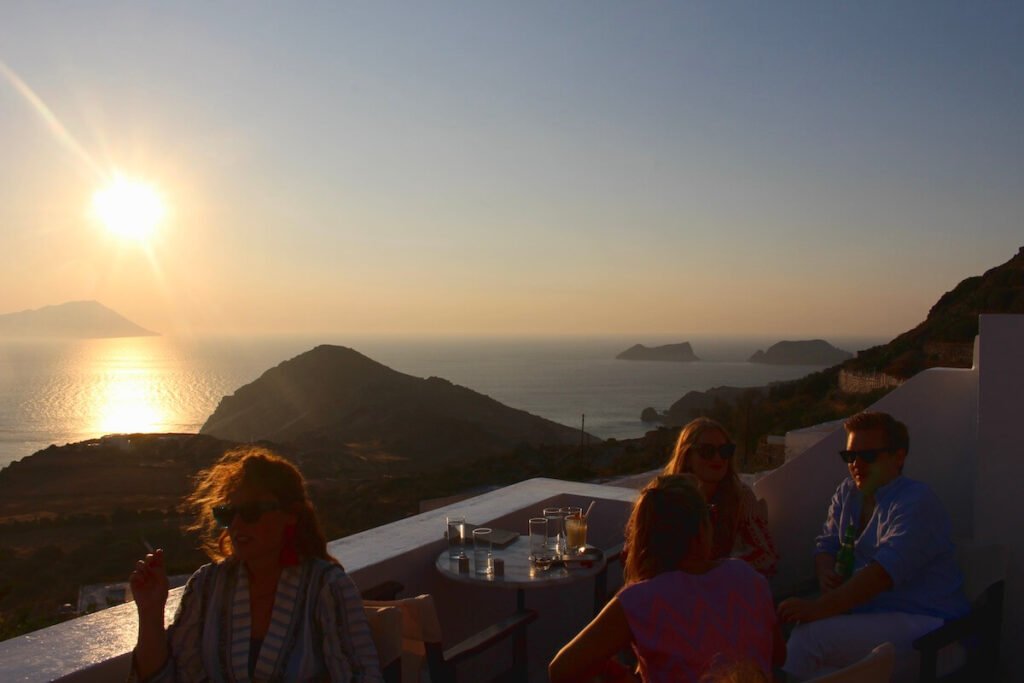
Embrace the beauty of Milos: Volcanic Landscapes and Hot Springs
Milos was once a hidden gem in the Cyclades. It is now steadily increasing in popularity as a sought-after Greek island destination. Its growing appeal is evident as you explore its volcanic landscapes, distinctive beauty and natural hot springs. Mixed with a low key Cycladic charm, Milos is definitely the Aegean’s next most sought after island. Make sure to visit whilst it is still in relative infancy – with every passing season, more restaurants and bars appear on its shores. That said, Milos is maintaining, at least up until now, its unspoiled beauty.




